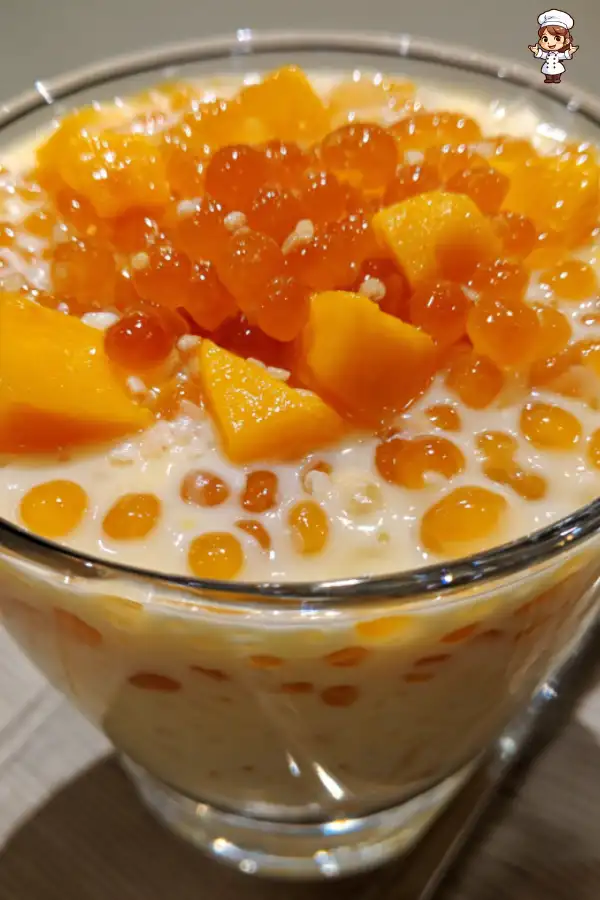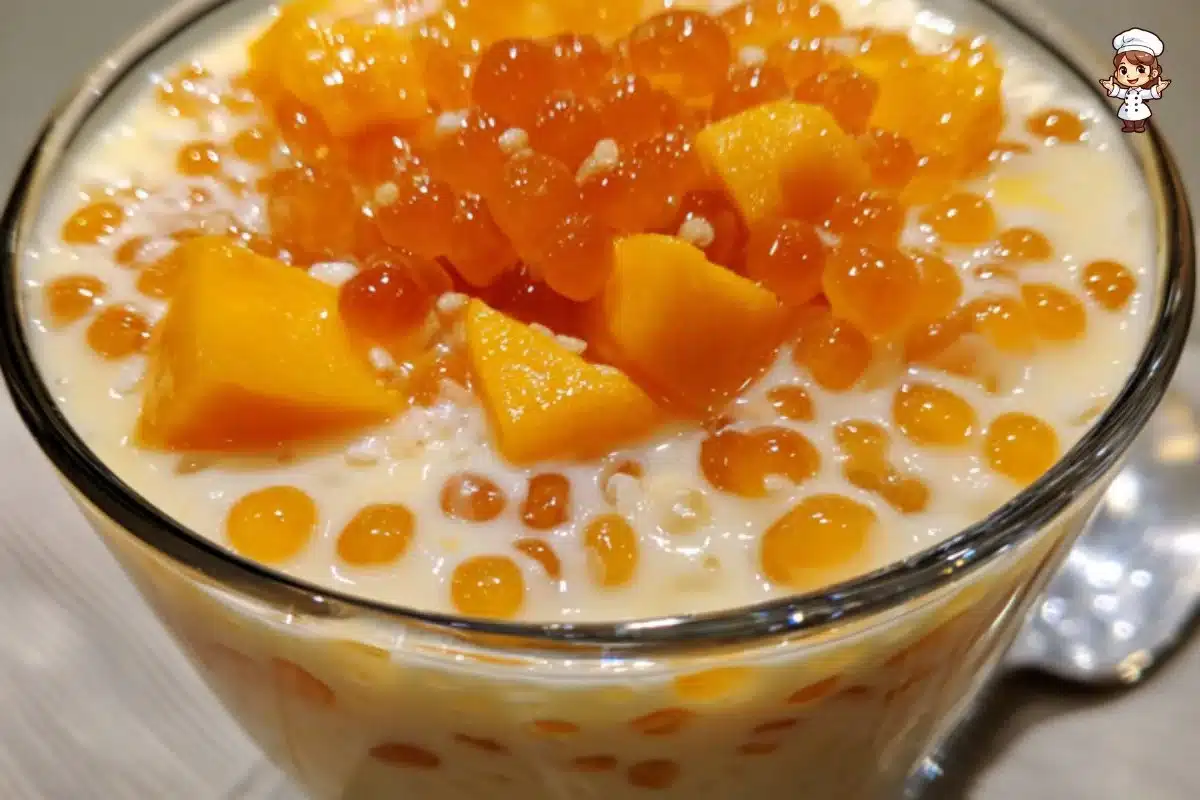Mango Sago is a delightful and refreshing dessert that originates from Southeast Asia. This sweet treat combines the tropical flavors of ripe mangoes with the chewy texture of small tapioca pearls, all enveloped in creamy coconut milk. Once you get a taste of Mango Sago, it’s easy to see why it’s become a popular choice in dessert shops and among home cooks alike. This dessert excels in its simplicity, with fresh ingredients blending perfectly to create a vibrant and satisfying end to any meal.
In addition to its great taste, Mango Sago is visually appealing, with bright yellow mangoes standing out against the soft, opaque white sago pearls. This dessert is often enjoyed chilled, making it perfect for warm weather settings or as a light indulgence after dinner. It’s an exciting way to explore the natural sweetness of mangoes while still enjoying a bit of fun with the sago pearls.
If you’re ready to dive into the tropical world of Mango Sago, here’s everything you need to learn about creating this delightful treat from scratch.
Ingredients about Mango Sago
List of ingredients with measurements
To prepare Mango Sago, you will need the following ingredients:
- 200 g small tapioca pearls
- 600 g mango chunks (approximately 5 small mangoes)
- 400 g coconut milk (1 can)
- 50 g sweetened condensed milk
Optional ingredient substitutions
For those who want to customize their Mango Sago, there are a few substitutions you can consider. If you don’t have small tapioca pearls, you can use larger pearls, though cooking times may vary. For a healthier option, you could replace sweetened condensed milk with a natural sweetener like honey or maple syrup. If you want a dairy-free version, simply use a sweetened coconut milk alternative or omit the condensed milk entirely.
How to Make Mango Sago

Step 1 : Detailed instruction
To start, grab a large pot and fill it with water. Bring the water to a boil over high heat. Once boiling, add the small tapioca pearls to the pot. It is crucial to stir immediately after adding the pearls to avoid clumping. After stirring, reduce the heat to a simmer and cook the pearls for about 10 minutes. Keep an eye on them to ensure they do not stick to the bottom of the pot.
Once the cooking time is up, turn off the heat and cover the pot. Allow the tapioca pearls to rest covered for an additional 10 minutes. This will help the pearls become completely translucent and chewy.
Step 2: Detailed instruction
After the resting period, take the pot and pour the cooked sago into a fine mesh sieve. You want to drain away all the hot water. To cool the sago and stop the cooking process, fill the same pot with cold water and place the sieve on top. Keep the sago submerged until you are ready to combine it with the mango mixture.
Step 3: Detailed instruction
In a blender, add about 600 g of fresh mango chunks, the full can of coconut milk, and the sweetened condensed milk. Blend these ingredients on high speed until you reach a smooth consistency. Once blended, taste the mixture. If you like your dessert a little sweeter, feel free to add more condensed milk to meet your taste preference before blending again.
Step 4: Detailed instruction
Now that your mango mixture is ready, pour it into a large serving bowl. Carefully add the drained sago to the mango mixture and gently stir to combine everything. Make sure the sago is spread evenly throughout the mango mixture for a beautiful and delicious dessert that presents well when served.
How to Serve Mango Sago
Best ways to serve Mango Sago
Mango Sago is best served chilled, making it an excellent choice for hot days or gatherings. Spoon the mixture into small bowls or individual glasses for an appealing presentation. If you want to elevate your serving, drizzle a bit of extra coconut milk on top, and garnish with fresh mango chunks. This adds visual appeal and enhances the sweetness of the dish.
Serving suggestions or pairings
Mango Sago pairs wonderfully with a variety of snacks or other desserts. Consider serving it alongside coconut macaroons for a tropical theme or enjoy it with a light, fluffy cake. For drinks, a simple iced tea or a fruity lemonade complements the dessert beautifully without overpowering its flavors.
How to Store Mango Sago
Proper storage methods
If you have leftovers, store the Mango Sago in an airtight container in the refrigerator. It can usually stay fresh for up to three days. Ensure that you keep it refrigerated at all times to maintain its quality.
Tips for reheating or freezing
Mango Sago is typically enjoyed cold, so reheating is usually not necessary or recommended. However, if you find yourself needing to store it longer, freezing is an option, though it may change the texture of the sago slightly. If you decide to freeze it, portion it out into small containers, leaving a bit of space for expansion, and consume it within a month for the best experience.
Tips to Make Mango Sago
Common mistakes to avoid
One common mistake to avoid is not stirring the sago pearls enough during the cooking process. Failure to stir can cause them to clump together, leading to an uneven consistency. Additionally, be careful not to overcook the sago; it should be chewy and translucent, not mushy.
Helpful tips for better results
For best results, use ripe and sweet mangoes for your Mango Sago. The taste of mango can make a significant difference in the overall quality of the dish. If you want a creamier texture in your mango mixture, consider blending in a bit of yogurt. This will create a unique version of the traditional dessert.
Variation of Mango Sago
Suggested variations or twists on the recipe
Mango Sago can be easily adjusted to incorporate other flavors or fruits. Consider adding a splash of pandan essence for a unique fragrance. You can also swap out mangoes for other fruits like kiwi or strawberries for a different twist. For the adventurous, mix in some crushed ice for a slushy version for those hot summer days.
Adjustments for dietary preferences
Those with dietary restrictions can opt for low-sugar or sugar-free condensed milk, or simply omit it altogether if looking for a healthier option. You can also use non-dairy milk, such as almond milk, to create a vegan-friendly dessert without sacrificing flavor.
FAQs
What can I do if the dish isn’t turning out right?
If your Mango Sago isn’t coming out as expected, check the consistency of the sago. It should be chewy and glossy, not gritty or hard. If it appears too clumped, ensure that you stir well during cooking and adjust your water-to-sago ratio.
Can I make this ahead of time?
Yes, Mango Sago can be made ahead of time and stored in the refrigerator. It is a great dessert for gatherings as you can prepare it a few hours in advance and simply serve it chilled when ready.
What can I substitute for ingredients?
If you lack tapioca pearls, you can try using sweet rice balls or even small amounts of gelatin for a different texture. If mangoes aren’t in season, you could use canned mango puree, but fresh fruit is always recommended for the best taste. Sweetened or unsweetened coconut alternatives work well if you’re looking for a low-calorie or different flavor profile.
By following this guide, you’ll be well on your way to creating a delicious Mango Sago that surely impresses anyone who gets to enjoy it. This dish brings together the best of tropical flavors and textures for a truly delicious dessert experience. Whether you’re serving it for a special occasion or a casual dinner at home, Mango Sago is bound to be a hit!
Print
Mango Sago
- Total Time: 30 minutes
- Yield: 4–6 servings 1x
- Diet: Vegetarian
Description
Mango Sago is a refreshing Southeast Asian dessert featuring ripe mangoes, chewy tapioca pearls, and creamy coconut milk served chilled.
Ingredients
- 200 g small tapioca pearls
- 600 g mango chunks (about 5 small mangoes)
- 400 g coconut milk (1 can)
- 50 g sweetened condensed milk
Instructions
- Bring a large pot of water to boil, add tapioca pearls, stir to prevent clumping, simmer for 10 minutes.
- Turn off heat, cover, and let pearls rest for 10 minutes until translucent.
- Drain tapioca pearls using a fine sieve, rinse under cold water to stop cooking.
- In a blender, combine mango chunks, coconut milk, and condensed milk; blend until smooth.
- Taste and adjust sweetness if needed by adding more condensed milk and blending again.
- Pour mango mixture into a large bowl, add drained tapioca pearls, and gently stir to combine.
- Chill mango sago in the refrigerator before serving.
Latest Amazon Finds
Notes
- Stir tapioca pearls frequently while cooking to prevent clumping.
- Do not overcook tapioca pearls to avoid mushy texture.
- Use ripe mangoes for best flavor.
- Chill the dessert well for optimal taste and texture.
- Adjust sweetness according to personal preference.
- Prep Time: 10 minutes
- Cook Time: 20 minutes
- Category: Dessert
- Method: Boiling, Blending
- Cuisine: Southeast Asian
Nutrition
- Serving Size: 1 cup (about 200g)
- Calories: 180
- Sugar: 22g
- Sodium: 15mg
- Fat: 6g
- Saturated Fat: 5g
- Unsaturated Fat: 1g
- Trans Fat: 0g
- Carbohydrates: 30g
- Fiber: 1g
- Protein: 2g
- Cholesterol: 0mg
Keywords: Mango Sago, Mango Tapioca Dessert, Mango Coconut Sago, Tropical Mango Dessert








